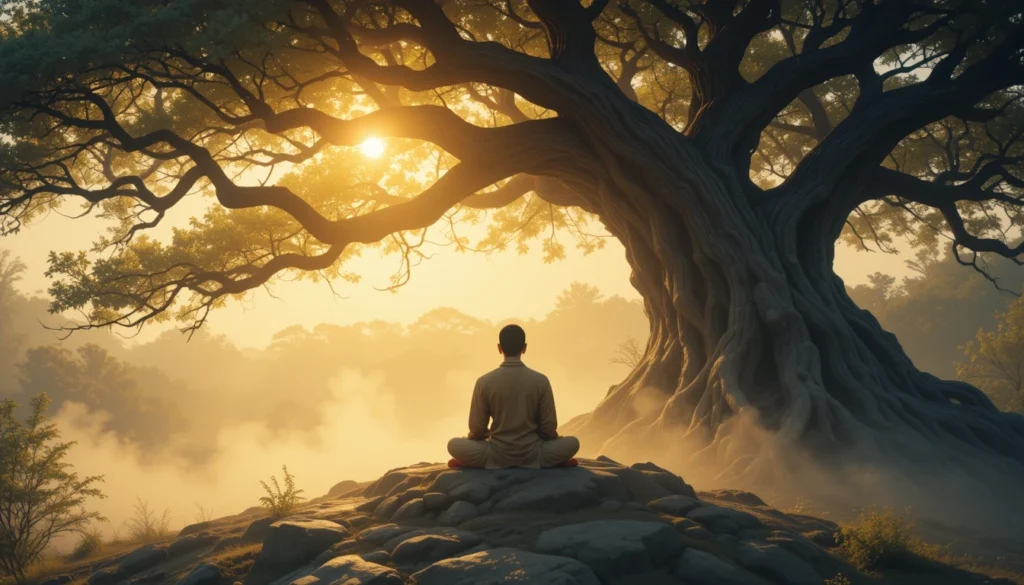We all crave freedom(Enlightenment). Not just a weekend getaway or a day without notifications, but a deeper kind—freedom from worry, fear, and the endless cycle of wanting more. This deeper liberation has a name: Enlightenment.
Imagine leaving behind your family, your wealth, and even your identity in pursuit of this invisible treasure. One man did just that. Siddhartha Gautama—the man we now call the Buddha—walked away from everything for the chance to understand life itself.
That’s the heart of this article: exploring what Enlightenment is, how it can be achieved, and whether it truly requires letting go of everything.
Beyond Buzzwords: Understanding True Enlightenment
Enlightenment isn’t a trendy hashtag or a fleeting moment of clarity. At its core, it represents a profound, irreversible shift in consciousness—a direct realization of one’s true nature beyond the ego, thoughts, and the constant churn of desire and aversion.
- Historical Roots: For millennia, traditions like Hinduism (Moksha), Buddhism (Nirvana), and Taoism have described Enlightenment as liberation from the cycle of suffering (Samsara). It’s not about gaining special powers, but seeing through the illusion of a separate, limited self. As the Upanishads declare: “Tat Tvam Asi” (Thou art That).
- Modern Misconceptions: Today, Enlightenment is often diluted. It’s confused with being “woke,” highly mindful, or perpetually blissful. True awakening is far more radical. It’s an existential earthquake that shatters the foundation of how we perceive reality itself.
- East vs. West: A Fundamental Divide:
| Aspect | Eastern View of Enlightenment | Western View of Enlightenment |
| Primary Goal | Liberation from suffering & illusion (Moksha/Nirvana) | Personal achievement, success, self-improvement |
| Path Focus | Inward (detachment, meditation, self-inquiry) | Outward (acquisition, accomplishment, status) |
| Self Concept | Ego as illusion to be transcended | Ego as identity to be strengthened |
| Ultimate State | Unchanging peace, unity with all existence | Peak performance, lasting happiness |
While the West often seeks fulfillment through the world, the Eastern path points to finding fulfillment beyond it.

The Radical Renunciates: Stories of Ultimate Letting Go
History is punctuated by those who dared to walk the razor’s edge:
- Siddhartha Gautama (The Buddha): Born a prince, surrounded by luxury and shielded from suffering, Siddhartha encountered old age, sickness, and death. This collision with reality sparked an insatiable question: “Why suffering?” At 29, he left his palace, wife, and newborn son, embarking on a grueling quest. His moment of Enlightenment under the Bodhi tree wasn’t an intellectual understanding but a direct, experiential realization of the nature of mind and the end of suffering.
- Ramana Maharshi: As a 16-year-old boy in Tamil Nadu, Venkataraman experienced a sudden, overwhelming fear of death. Lying perfectly still, he consciously explored “What dies? Who am I?” This intense self-inquiry led to an immediate, profound awakening. He soon left home for the sacred mountain Arunachala, spending years in silent absorption, embodying the purest state of Self-realization.
- Contemporary Pathfinders: Figures like Eckhart Tolle and Mooji demonstrate that awakening isn’t confined to ancient history or remote caves. Tolle’s transformation occurred after a period of intense despair, leading to a state of sustained presence. Mooji, a former London artist, was drawn to his teacher, Papaji, and now guides others through self-inquiry. They prove Enlightenment can ignite amidst modern chaos.
Why Choose the Path of Nothing? The Pull Toward Awakening
What drives someone to potentially abandon everything? It’s rarely a casual decision:
- The Crushing Weight of “More”: Materialism promises fulfillment but often delivers emptiness. The constant chase for possessions, status, and experiences can become a soul-numbing burden. As Buddha observed, attachment is the root of suffering.
- An Unbearable Inner Turmoil: When the noise of the mind—the anxieties, regrets, and relentless wanting—becomes deafening, the promise of inner silence becomes irresistible. It’s a desperate thirst for genuine peace.
- The Burning Question “Who Am I?”: Beyond roles, jobs, and relationships lies a fundamental mystery. For some, this question becomes paramount, eclipsing all worldly concerns. The drive to know one’s true essence supersedes the need for security or social approval.
The Journey Itself: From Seeking to Being
The path to Enlightenment is less about reaching a destination and more about an unfolding process:
- Renunciation & Detachment (Vairagya): This is often misunderstood. True renunciation isn’t necessarily abandoning the world physically (though it can be). It’s an inner letting go—releasing attachment to outcomes, identities, possessions, and even the idea of becoming enlightened. It’s cultivating non-clinging.
- Meditation (Dhyana) & Self-Inquiry (Atma Vichara): These are the core practices.
- Meditation: Cultivates stillness, allowing the mind’s turbulence to settle, revealing the aware space beneath thoughts. It trains attention and fosters insight.
- Self-Inquiry: Ramana Maharshi’s central practice. Relentlessly asking “Who am I?” or “To whom do these thoughts arise?” peels back layers of false identity, directing attention to the source of consciousness itself.
- The Role of the Guru/Guide (Satguru): While not essential for all, a genuine teacher who embodies the state can be invaluable. They offer guidance, dispel misconceptions, provide direct transmission of understanding (Satsang), and help navigate the pitfalls of the spiritual path. They point the way when the seeker is lost in the mind’s labyrinth.
The Inner Crucible: Psychological Shifts on the Path
Awakening isn’t always blissful; it involves profound psychological restructuring:
- Ego Death – The Great Undoing: This isn’t literal annihilation, but the dissolution of the false, separate sense of self (the “I” story). It can feel terrifying as familiar anchors vanish, but it reveals the vast, peaceful ocean of pure awareness beneath the ego’s turbulent waves.
- Identity Crisis or Awakening?: Intense disorientation, loss of interest in old pursuits, and emotional upheaval can signal either a psychological crisis or the early stages of awakening. The key difference? Crisis feels like falling apart with no ground. Awakening, even amidst turmoil, carries a subtle sense of underlying peace and rightness in the dissolution.
- Beware Spiritual Bypassing: Using spiritual ideas or practices (like forced positivity or detachment) to avoid unresolved psychological wounds, trauma, or difficult emotions is a dangerous trap. True Enlightenment integrates and heals the shadow, not avoids it.
The Price of Freedom: What Letting Go Can Cost
Choosing the radical path carries undeniable challenges:
- Profound Loneliness: Detaching from societal roles and norms can create a chasm of misunderstanding. Few grasp the depth of the journey, leading to isolation.
- Social Disconnection: Conversations focused on acquisition, status, or trivialities may lose meaning. Relating to the “normal” world becomes challenging, though deeper, more authentic connections can emerge.
- Material Uncertainty: Renouncing conventional careers and possessions often means embracing radical simplicity and dependence on the generosity of others or minimal means. Security is found inwardly, not financially.
The Unshakeable Freedom: The Rewards of Awakening
The fruits of Enlightenment, however, are considered priceless:
- Unbroken Inner Stillness: A profound peace that persists regardless of external circumstances. The storm may rage, but the depths of the ocean remain calm.
- Freedom from Suffering: Pain, loss, and difficulty remain part of human life, but the suffering—the mental resistance, the story-making, the identification with pain—dissolves. Pain is experienced without the added layer of “This shouldn’t be happening to me!”
- Unconditional Joy & Equanimity: A deep-seated contentment and well-being unrelated to specific causes. Joy arises from simply being. Equanimity allows one to meet life’s highs and lows with balance and grace.
Is Radical Renunciation Essential? Enlightenment in Everyday Life
Must everyone abandon their job, family, and home? The resounding answer from many traditions is: No.
- The Buddha’s Middle Way: After experiencing both extreme asceticism and princely indulgence, Buddha advocated the Middle Path—avoiding extremes, living ethically, cultivating mindfulness, and developing wisdom within the context of daily life.
- Living In, Not Of, the World: Enlightenment is an inner state. It’s possible to engage with family, career, and society while being rooted in the awareness that transcends them. Action flows from presence, not egoic craving or aversion. As the Bhagavad Gita teaches: “Perform your duty established in Yoga, abandoning attachment, and remaining even-tempered in success and failure.”
- Integration: Spirituality in the Mundane: This is the essence for most modern seekers:
- Transform daily routines (washing dishes, commuting) into mindfulness practices.
- Use challenging relationships or work situations as opportunities for self-observation and breaking reactive patterns.
- Practice self-inquiry amidst daily activities (“Who is stressed right now?”).
- Cultivate conscious choices rather than unconscious habits.

Navigating the Western Maze: Spirituality in a Hustle Culture
The modern West presents unique challenges and opportunities:
- Hustle vs. Harmony: Can ambition coexist with inner peace? It depends. If driven by egoic insecurity and greed, it fuels suffering. If aligned with a deeper sense of purpose and service, action can be an expression of presence. The key is non-attachment to outcomes.
- Wealth and Awakening: Abundance isn’t the enemy; attachment is. Wealth can be a powerful tool for service and reducing suffering if held lightly and used wisely. The challenge lies in not letting possessions possess you.
- The Power of Conscious Choice: You don’t need to renounce the world to renounce attachment to the world. This shift happens internally.
Micro-Practices: Cultivating Enlightenment Now
You don’t need a Himalayan cave:
- Micro-Retreats: Dedicate 5 minutes every hour for conscious breathing. Take a full day offline each month. Observe nature mindfully.
- Mindful Living: Bring full attention to one mundane task daily—brushing teeth, drinking tea, walking. Notice sensations without judgment.
- Question Your “Self”: When stressed, ask: “Who is feeling this?” or “Is this thought really true?” Challenge automatic identification.
- Gratitude & Service: Shift focus from lack to appreciation. Engage in small acts of kindness without expectation.
Would You Be Willing? A Mirror for Your Soul
The question isn’t about mimicking ancient ascetics. It’s about depth of commitment:
- What inner attachments (to my self-image, beliefs, comforts, security) am I truly unwilling to examine or release?
- What am I most afraid of losing, and why?
- Is my search for peace contingent on external conditions changing?
- Am I chasing experiences (even spiritual ones) or seeking the experiencer itself?
What Are You Really Seeking? Beneath the desires for success, love, or security, is there a quieter longing for something unshakeable, unchanging—a fundamental peace and understanding?
Conclusion: Embracing Reality, Not Escaping Life
The man who gave up everything didn’t reject life; he sought its ultimate truth. Enlightenment isn’t an escape from the world, but a radical embrace of reality as it is, seen with unobscured clarity. It’s the realization that the freedom you seek isn’t found in acquiring more or becoming someone else, but in recognizing the boundless awareness you already are, right here, right now.
The path looks different for everyone. For a rare few, it demands utter external renunciation. For most, it’s an inner revolution—a continuous letting go of mental clutter, false identities, and attachments while fully engaging in the human experience. It requires courage, honesty, and unwavering self-inquiry.
The ultimate question isn’t “Could you give up everything?” but “Are you willing to see everything—including your very self—with fearless clarity?” That willingness is the first, and most crucial, step on the timeless journey to Enlightenment.
FAQs: Unraveling Common Questions on Enlightenment
- Can someone achieve Enlightenment without meditating for hours?
Absolutely. While meditation is a powerful and common tool, Enlightenment can arise through intense self-inquiry (like Ramana Maharshi), deep devotion (Bhakti Yoga), spontaneous awakening, or even through profound suffering that shatters the ego. The key is the shift in consciousness, not the specific method. - Does Enlightenment mean you become emotionless or perfect?
Not at all. Enlightened beings fully experience the human spectrum of emotions—joy, sadness, anger. The difference is they don’t identify with these emotions. They arise and pass like weather patterns in the sky of awareness. There’s no clinging or aversion. They also aren’t “perfect” in a worldly sense; they remain human, free from the illusion of separation and the suffering it causes. - Is giving up family and career necessary in today’s world?
For the vast majority, radical external renunciation is neither practical nor necessary. The essence is inner renunciation—letting go of attachment, egoic clinging, and the belief that external things provide lasting fulfillment. Deep awakening can and does happen to householders, professionals, and parents who practice presence and self-inquiry amidst their responsibilities. - Can you be Enlightened and still have goals or ambitions?
Yes. Goals can arise naturally from a place of clarity and service, rather than egoic craving or fear. An enlightened being might work tirelessly for a cause, but they are not attached to the outcome. The peace isn’t dependent on success or failure. Action happens, but without the internal struggle for “more” or “better” for the separate self. - How can I tell if I’m making progress towards Enlightenment?
Look for subtle shifts: Increased moments of inner quiet and presence, reduced reactivity to triggers, a lessening of self-centered thoughts, a growing sense of compassion and interconnectedness, decreased attachment to opinions and outcomes, and a deepening acceptance of what is. Progress isn’t linear and often feels like deepening humility and “not knowing.”



